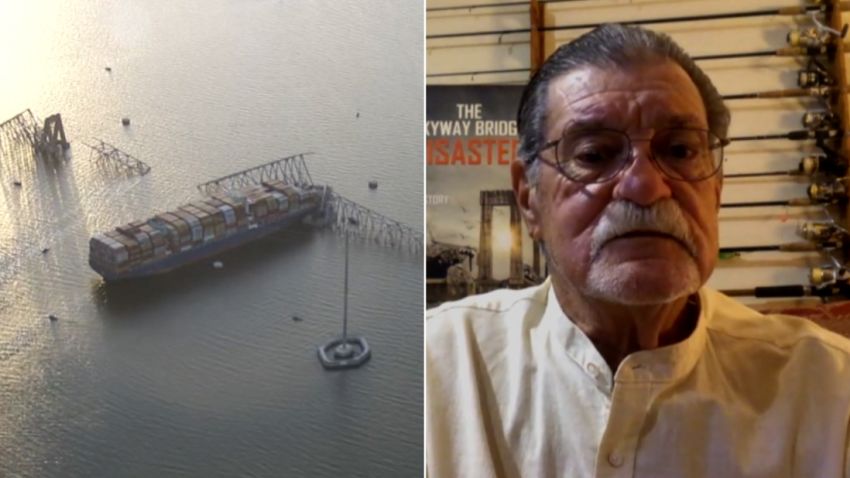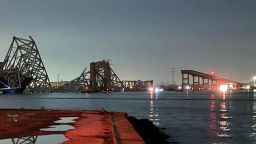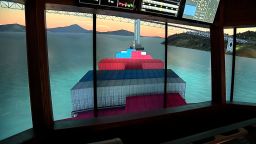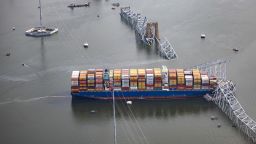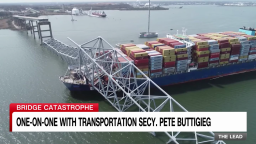Maryland officials are moving at “full speed” on several priorities after a 984-foot-long cargo ship struck and collapsed Baltimore’s Francis Scott Key Bridge, including reopening the shipping channel and restarting traffic through the Port of Baltimore, Maryland Gov. Wes Moore said at a Thursday news conference.
Moore’s other directives in the wake of the bridge collapse, which killed six of the eight construction workers who fell from the bridge Tuesday into the Patapsco River, include taking care of the people affected by the crisis.
This means families of the people presumed dead, the workers, first responders — “that means everybody,” Moore said. Besides eventually rebuilding the bridge, the governor stressed a focus of continued recovery efforts, adding that it is “our obligation to bring a sense of closure to these families.”
“This work will not take days. This work will not just take weeks. We have a very long road ahead of us,” said Moore, who said there have been over 2,400 feet of boom deployed to contain any leaks of possible toxic materials from the ship.
Officials working to remove the collapsed Key Bridge from the channel are conducting a full assessment of all of the pieces of debris before they can lift them out of the water, according to US Coast Guard Rear Adm. Shannon Gilreath. This appraisal is critical in figuring out how to cut the bridge into the right sized pieces so cranes can lift them out, he said.
“We are doing those assessments right now with underwater surveys, with engineering teams back in unified command,” Gilreath said, adding that the assessment is in coordination with several other partners, including the US Army Corps of Engineers.
The Army Corps will cover the full cost of clearing the channel where the bridge collapsed, Maryland Sen. Chris Van Hollen said Thursday.
The Army Corps is also moving the largest crane in the Eastern Seaboard to Baltimore to help clear the channel. Moore said it is expected to arrive later Thursday evening.
Federal transportation officials said Thursday they would provide the $60 million requested by Moore as a “down payment” towards cleaning up and rebuilding the Key Bridge. Federal Highway Administration chief Shailen Bhatt said the emergency funding would “help Maryland manage ongoing disruptions to traffic, supply chains and daily life.”
The funds, requested by state officials earlier Thursday, will go toward removing debris, rerouting traffic and ultimately rebuilding the bridge. The state can later request additional funding, and the state’s congressional delegation said they would press fellow lawmakers to fund the rebuilding project.
Meanwhile, the two pilots of a cargo ship are expected to be interviewed by authorities Thursday as crews prepare for a risky salvage mission ahead.
The captain of the mammoth vessel, his mate, the ship’s chief engineer and another engineer have already been interviewed by the National Transportation Safety Board, said NTSB chair Jennifer Homendy.
Investigators have secured the voyage data recorder from the 213-million-pound ship, the Dali, and learned new clues about what led up to Tuesday’s fatal crash that killed a group of construction workers – including four victims who have yet to be found.
The first sign of distress came just under three minutes before the crash when the cargo ship’s pilot called over the radio requesting any tugboats in the area to respond to the vessel, Homendy said.
Within a minute, police officers on both ends of the bridge were ordered to stop traffic crossing the bridge, said Marcel Muise, the NTSB investigator in charge of the collapse inquiry. Officials have credited this swift action for saving lives.
During their first full day at the scene Wednesday, investigators saw the “utter devastation” of the mangled bridge – pieces of which are still draped over the ship’s bow, Homendy said.
“When I look at something like that, I am thinking not about the container ships that are coming through, not about traffic getting back up and running on the bridge. I’m thinking about the families who’ve lost loved ones,” Homendy said.
Authorities believe six construction workers were killed in the disaster. Two bodies were found Wednesday. Four victims remain missing and are presumed dead, but the search for their bodies has paused until salvage crews can clear heavy underwater debris that is believed to be encasing their remains.
“That water is so dark and the debris is so dense that in most instances, our divers cannot see any more than a foot or two in front of them,” Moore said.
Cargo ship crash timeline
It will take months for investigators to gather the piles of physical evidence, maintenance records, ship data and witness interviews required to deliver a full report on the accident, Homendy said.
But using information from the ship’s voyage data recorder, or VDR, the NTSB pieced together a rough timeline of events leading up to the crash:
• About 12:39 a.m.: The ship left the Seagirt Marine Terminal.
• By 1:07:00 a.m.: The ship had entered the Fort McHenry Channel.
• 01:24:59 a.m.: Numerous audible alarms were recorded on the ship’s bridge audio. At about the same time, the VDR stopped recording ship system data but was able to keep recording audio using a different power source.
• 01:26:02 a.m.: The VDR resumed recording ship system data. During this time, steering commands and orders regarding the rudder were captured on audio.
• 01:26:39 a.m.: The ship’s pilot made a general very high frequency (VHF) radio call for tugboats in the vicinity to help the vessel. Around this time, the pilot association dispatcher contacted the Maryland Transportation Authority duty officer about the blackout, according to transit authority data.
• Around 01:27:04 a.m.: The pilot ordered that the ship’s port anchor be dropped and issued additional steering commands.
• Around 01:27:25 a.m.: The pilot issued a radio call over the VHF radio, reporting that the vessel had lost all power and was approaching the bridge. Around this time, the transit authority duty officer radioed two of its units — one on each side of the bridge — that were already on scene and ordered them to close traffic on the bridge. All lanes were then shut down.
• Around 01:29 a.m.: The ship’s foward speed was recorded at just under 8 miles per hour. From this moment until around 1:29:33, the VDR audio recorded sounds consistent with a crash at the bridge. MDTA dash cameras show the bridge lights extinguishing.
• 01:29:39 a.m.: The pilot radioed the US Coast Guard to report the bridge was down.
New details emerge about those on the ship
The Dali, a Singaporean-flagged container vessel, had 23 people on board – 21 crew members and two pilots.
Of the 21 crew members, 20 are Indian nationals who are “in good shape,” India’s Ministry of External Affairs said Thursday.
Only one member was slightly injured and required some stitches, said spokesperson Randhir Jaiswal.
All crew members were still onboard the cargo ship as of Thursday, said an Indian Ministry of External Affairs senior official familiar with the matter.
The ship was chartered to carry cargo by Danish shipping giant Maersk and was leaving the Baltimore area at the time of the crash.
There were no issues reported with the ship prior to its arrival in Baltimore, officials said Wednesday. “We were informed that they were going to conduct routine engine maintenance on it while it was in port,” Coast Guard Rear Admiral Shannon Gilreath said. “That’s the only thing we were informed about the vessel in that regard.”
A dangerous salvage mission ahead
Of the eight construction workers who fell into the frigid, 50-foot-deep Patapsco River during the bridge collapse, only two survived.
Authorities said two victims’ bodies were found Wednesday, trapped in a red pickup stuck underwater. They were identified as Baltimore residents Alejandro Hernandez Fuentes, originally from Mexico, and Dorlian Ronial Castillo Cabrera, originally from Guatemala.
But the search for the four missing construction workers has stalled due to treacherous conditions for divers above and beneath the water.
Those perils include sharp debris hidden in the dark water, unstable pieces of wreckage that could fall at any time, rainy weather, and the presence of hazardous materials aboard the ship.
It’s possible the missing victims are trapped under the concrete and tangled debris from the bridge’s “superstructure” underneath the water, officials said Wednesday.
But after the salvage mission begins and the superstructure is removed, “divers are going to go back out there and bring those people closure,” said Maryland State Police Superintendent Col. Roland L. Butler.
While officials hope to clear the debris as soon as possible, “we’re still very cognizant of the fact that there are hazardous materials aboard the vessel itself,” Baltimore City Fire Chief James Wallace said Wednesday.
A senior NTSB hazmat investigator identified 56 containers with 764 tons of hazardous material, the agency said. The hazardous materials mostly include corrosives and flammables, as well as some lithium-ion batteries.
Earlier, Coast Guard Vice Admiral Peter Gautier said there is no hazmat threat to the public. Of the ship’s 4,700 cargo containers, only two went missing overboard, and neither contained hazardous materials, he said.
In addition to recovering the remaining victims for their families, officials are also hoping to reopen the waterway soon to prevent more harm to the thousands of workers whose jobs are impacted by the port’s closure.
The Baltimore port is the largest in the US for autos and light trucks, handling a record 850,000 vehicles last year.
But it’s not clear exactly when the wreckage will be cleared.
“It’s going to be very difficult, if not impossible, and very dangerous to place people on the bow of that boat right now,” Wallace told CNN Wednesday night.
“My sense is that it’s going to be a couple of days,” Wallace said, citing “a lot of instability on the crash scene.”
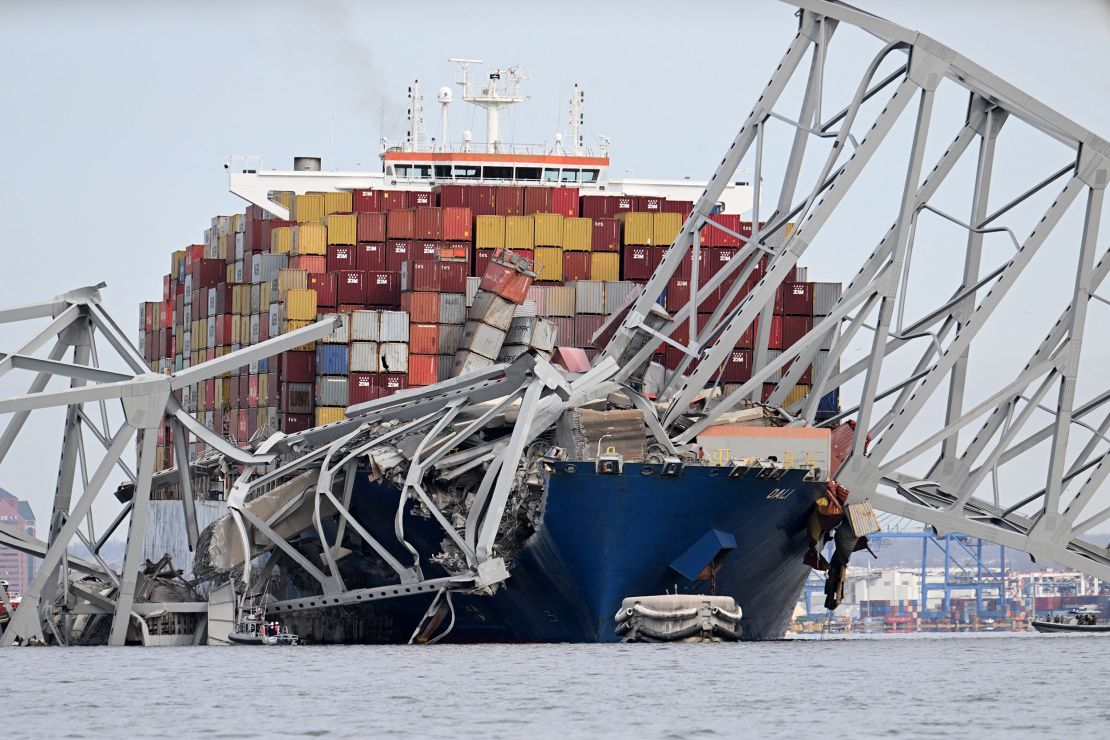
Bridge has been struck before – and survived
Unlike most bridges built today, the Key Bridge – completed in 1977 – is “fracture critical,” the NTSB chair said.
“What that means is if a member fails that would likely cause a portion of, or the entire bridge, to collapse. There’s no redundancy,” Homendy said.
Tuesday’s catastrophe was not the first time a vessel has slammed into the Key Bridge. Four decades ago, another container ship that also lost power hit the same bridge — and it stood strong.
The dramatic difference in outcomes between the two accidents is an example of the dangers caused by the massive increase in shipping vessel size in the intervening decades.
A CNN review of public records and interviews with about a dozen bridge and shipping experts show that hundreds of bridges over US waterways were built decades ago when container ships were a fraction of the size and weight they are today. Bridges of the era when the Key Bridge was built weren’t designed to protect against collisions with ships as big as the Dali, the vessel that caused the Baltimore to topple.
The Dali has a capacity of about 10,000 20-foot equivalent units of cargo – compared to the approximate cap of about 2,500 20-foot equivalent units that could be carried by container ships in the 1970s, CNN has reported.
Some experts said this week’s disaster should inspire engineers to reevaluate whether America’s aging infrastructure can withstand impacts from the gigantic ships that traverse our waterways today.
“It’s absolutely a wake-up call,” said Rick Geddes, a professor and director of Cornell University’s Program in Infrastructure Policy. “The people who were building the Francis Scott Key Bridge never really contemplated ships of this size. It wasn’t their fault — they just didn’t have a crystal ball.”
Ship and management company involved in previous incidents
The Dali vessel and its management company, Synergy Marine Group, have also come under scrutiny.
The ship was briefly held at the Port of San Antonio in Chile on June 27, 2023, when an inspector found that the pressure gauges for the vessel’s heating system were “unreadable,” a spokesperson for the Chilean Navy said.
And ships managed by the Synergy Marine Group have been involved in at least three deadly incidents since 2018 in Australia, Singapore and the Philippines, according to officials in those countries.
In 2018, a member onboard a vessel managed by Synergy in Australia was killed in an accident involving the ship’s personnel elevator, according to a report from the Australian Transportation Safety Bureau.
In 2019, an officer on a Synergy-registered vessel in Singapore was reported missing after “likely (falling) overboard while performing inspection or cleaning jobs,” according to a report by the Transport Safety Investigation Bureau of Singapore’s Ministry of Transport.
And in 2023, at least one sailor was killed when a Synergy Marine-managed tanker collided with a dredging ship in the Philippines, causing it to capsize, according to an incident report from the Philippines Coast Guard.
Synergy Marine Group is currently focused on the Baltimore incident, spokesperson Charlie Ridgeway told CNN on Wednesday. “It would be inappropriate to discuss any previous incidents at this time,” he said.
CNN’s Sarah Engel, Curt Devine, Casey Tolan, Isabelle Chapman, Daniel Medina, Sahar Akbarzai, Melissa Alonso, Hande Atay Alam, Lucas Lilieholm, Vedika Sud, Sania Farooqui and Aditi Sangal contributed to this report.




